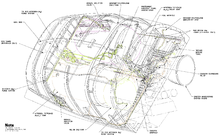- Space Shuttle Orbital Maneuvering System
-
The Space Shuttle Orbital Maneuvering System, or OMS (pronounced /omz/), is a system of rocket engines designed and manufactured by Aerojet[1] for use on the space shuttle orbiter for orbital injection and modifying its orbit.[2] It consists of two "packs" at the back of the Shuttle, the large lumps on either side of the vertical stabilizer. Each pack contains a single hypergolic OME engine (AJ10-190).,[3] based on the Service Propulsion System on the Apollo Service Module, with a thrust of 6,000 lbf (27 kN) and a Specific impulse of 313 seconds, which can be reused for 100 missions and is capable of 1,000 starts and 15 hours of firing. The OMS pods also contain the rear set of reaction control system (RCS) engines as well, which are referred to as the OMS/RCS. The fuel used is monomethylhydrazine (MMH), which is oxidized with nitrogen tetroxide (N2O4). The Shuttle has enough fuel, 8,174 kilograms (18,020 lb) of MMH and 13,486 kilograms (29,730 lb) of oxydizer, for about 1,000 feet per second (300 m/s) of delta-V using the OMS.[4][5]
Depending on the ascent profile of the mission, the OMS engines may also be used to assist acceleration to orbit.[2]
Orbital maneuvering system can be used to describe any system for moving about in orbit, so the term is found in non-Shuttle related topics as well, such as the proposed Reaction Engines Skylon, a single stage to orbit spaceplane.
References
- ^ Capability and flight record of the versatile space shuttle OMS engine
- ^ a b NASA (1998). "Orbital Maneuvering System". National Aeronautics and Space Administration. http://science.ksc.nasa.gov/shuttle/technology/sts-newsref/sts-oms.html. Retrieved February 8, 2008.
- ^ Encyclopedia Astronautica (2009). "OME at the Encyclopedia Astronautica". Encyclopedia Astronautica. http://www.astronautix.com/engines/ome.htm. Retrieved January 4, 2010.
- ^ NASA (1998). "Propellant Storage and Distribution". NASA. http://spaceflight.nasa.gov/shuttle/reference/shutref/orbiter/oms/storage.html. Retrieved February 8, 2008.
- ^ Spacecraft Fuel
External links
NASA Space Shuttle (STS) Core topics 


Components Orbiter Vehicle (OV) · Solid Rocket Booster (SRB) · External Tank (ET) · Main Engine (SSME) ·
Orbital Maneuvering System (OMS) · Reaction control system (RCS) · Thermal protection system · Booster separation motorOrbiters Add-ons Sites Operations Missions (cancelled) · Crews · Mission timeline · rollbacks · Abort modes · Rendezvous pitch maneuverTesting Disasters Support Special Derivatives Related Space Shuttle design process · Inertial Upper Stage · Payload Assist Module · ISS · Space Shuttle retirement · Explorer (shuttle replica)Categories:- Space Shuttle program
- United States spacecraft stubs
Wikimedia Foundation. 2010.




